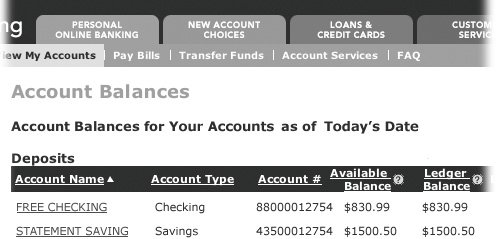Section 9.1. Online Banking
9.1. Online BankingMany major American banksCitibank, JP Morgan Chase, Washington Mutual, and so onhave online banking capabilities. In most cases, all you need to sign up is your ATM/debit card, personal identification number (or PIN, otherwise known as your ATM passcode), and one of your bank account numbers . Check your monthly bank statement for the digits. Most banks require that you use a relatively modern browser (technically, one that offers 128-bit encryption). If you're using Internet Explorer 5.5 or later on Windows, Safari on the Mac, or Firefox on either Mac or Windows, you should be fine. Once you sign up online, you can log into your bank's Web site just like you'd log in to eBay, Amazon, or any other password-protected Web site. Once you're logged in, you can do a number of things with your accounts online, including:
Figure 9-1. Here at Washington Mutual, you can see exactly how much money is in each of your accounts with a quick trip to the bank's online branch. The main thing you can't do online is deposit physical items like checks and cash into your account; they're a little hard to stuff through an Internet connection, no matter how broad your band is. But you can do things like check to make sure your paycheck's direct deposit has landed, transfer money between checking and savings accounts, and do a lot of the little things that used to mean, at the very least, hauling yourself to an ATM. Many banks also let you download your financial data to programs like Quicken or Microsoft Money. Note: If you do your financial business from a Windows computer, keep your computer safe with the suggestions in Chapter 21, especially by installing an Internet security suite and an anti-spyware program. These programs protect your computer from Internet invaders who'd like nothing more than to swipe your secret passwords and account information for their own nefarious purposes. 9.1.1. Paying BillsTired of running out of checks, getting paper cuts from return envelopes, or scrounging around for increasingly expensive postal stamps? With online bill payment, you can chuck all that into the shredder and disburse your utilities, services, and other bills with convenient , tree-friendly electronic payments. What's especially great about paying bills electronically isactually, there are two great things. First, you can set up recurring regular payments (like your mortgage or cable TV bill) to go out automatically, so you don't forget. Say goodbye to late fees and service charges. Second, you can sit down and do your bills all in one session, even though their due dates are scattered throughout the month. You just tell your bank when you want each one mailed, essentially postdating all of your payments. The beauty here is that the money stays in your account until the last possible moment, earning interest for you (instead of for the utility, phone, or cable company, which would have happened if you'd paid early ). There are three ways to pay bills online:
When you pay your bills online, you get an onscreen record of the transaction and can keep track of past and present payments. With the online record of all your bills, you get the extra benefit of having a running record of your monthly expenditures. This is helpful if you're on a tight budget and want to keep a close watch on your funds. If you do any contract or freelance work where you can deduct certain utilities and services as part of your home office setup, having a electronic record of all your paid bills comes in especially handy during tax-preparation season . Tip: Online services like America Online and MSN offer bill-payment options, too.
|
EAN: 2147483647
Pages: 147
- The Second Wave ERP Market: An Australian Viewpoint
- The Effects of an Enterprise Resource Planning System (ERP) Implementation on Job Characteristics – A Study using the Hackman and Oldham Job Characteristics Model
- Data Mining for Business Process Reengineering
- Intrinsic and Contextual Data Quality: The Effect of Media and Personal Involvement
- A Hybrid Clustering Technique to Improve Patient Data Quality